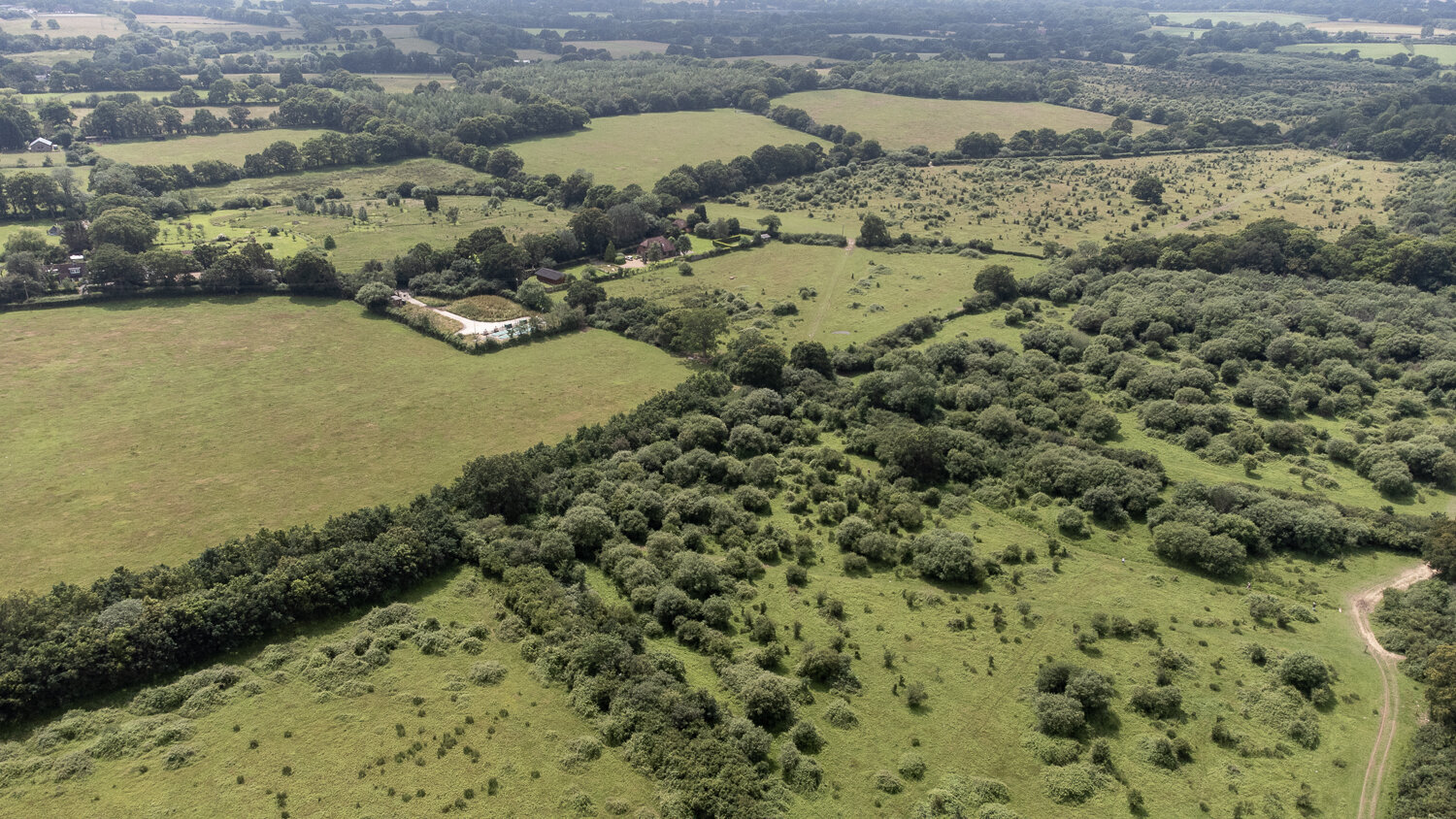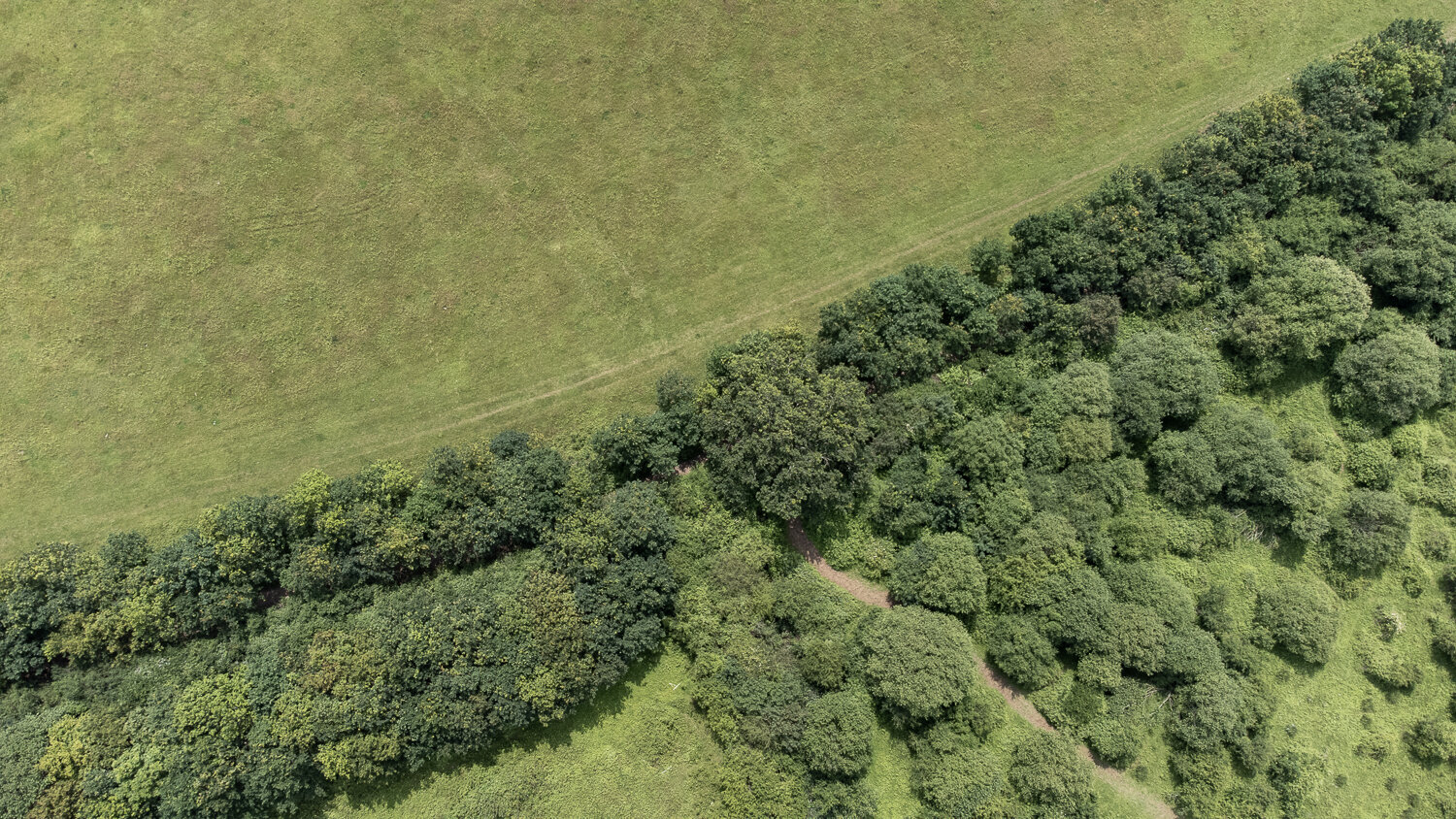Episode 7: Isabella Tree and Charlie Burrell @ Knepp Wildlands
“The most important thing about rewilding is you’ve just got to go ahead and do it”
Isabella Tree, writer and conservationist, and Charlie Burrell, rewilder and owner of Knepp Estate, West Sussex, with their famous dead tree in the background. Taken on a Mamiya 7, hand developed.
What on earth do you say to the people who effectively started a movement? What question can you possibly ask that they haven’t already heard a hundred times? Well, as I’m sure you can imagine, I had this kind of question going through my head when I was waiting to meet Isabella - Issy - Tree and Charlie Burrell and talk to them about all their rewilding work at Charlie’s family estate, Knepp, in West Sussex. After all, it was Isabella’s book Wilding which inspired me to do this work and to get back to my academic roots in biodiversity.
In truth, I should not have worried. In that visit, and when I have seen them since, they have been consistently charming, generous with their time, willing to talk and always welcoming. They also consistently show what seems to be a mixture of surprise and wonder at what has happened at Knepp after their big decision more than 20 years ago, which is refreshing.
“Because it is such a positive story, people feel hopeful”
So, this is the first of two episodes and three podcasts from Knepp. This episode focuses on Isabella and Charlie, linking to their interview and with portraits of them and photos of the rewilding area; known as the Wildlands. In these images I am trying to capture the essence of the Wildlands with colour digital imagery, some audio and some drone footage.
The challenge with this type of photography is showing something that is not ‘just’ vegetation, stock animals, or traditional wildlife photography, but which really captures rewilding, which is why I prefer the mixed media approach. As Issy says herself in the podcast (paraphrased), ‘there is a need for imagery that captures the essence of rewilding by people who understand the natural processes taking place’; I hope to be that person.
View of the ‘water hole’ from one of the lookouts at Knepp
The subsequent episode will follow involve Penny Green and Ivan De Klee, the Knepp rewilding team, and Pat Toe, their estimable stockman. there are a further range of images in that visit, a little different to what I have here.
Meeting an icon
My Knepp story starts in mid September 2020 after a series of Covid related delays. It was probably one of the hottest days of the year, and Knepp was hosting Joanna Lumley for her ITV series about the UK. This seems to be typical of the interest in the project, one week there is a film crew, the next, an international conference.
As I was coming over, I was asked if I could get there for 7am and take some ‘on-set’ photos of Joanna, Charlie and Issy. Having never photographed a celeb before, and living 2 and a half hours away, it was nerve-wracking but the photos were ok and the content of the show was great - you can see it here at about 36 mins in. Ms Lumley was charming.
“Everything you are talking about is rewilding your brain, you’ve suddenly got to think differently about things..”
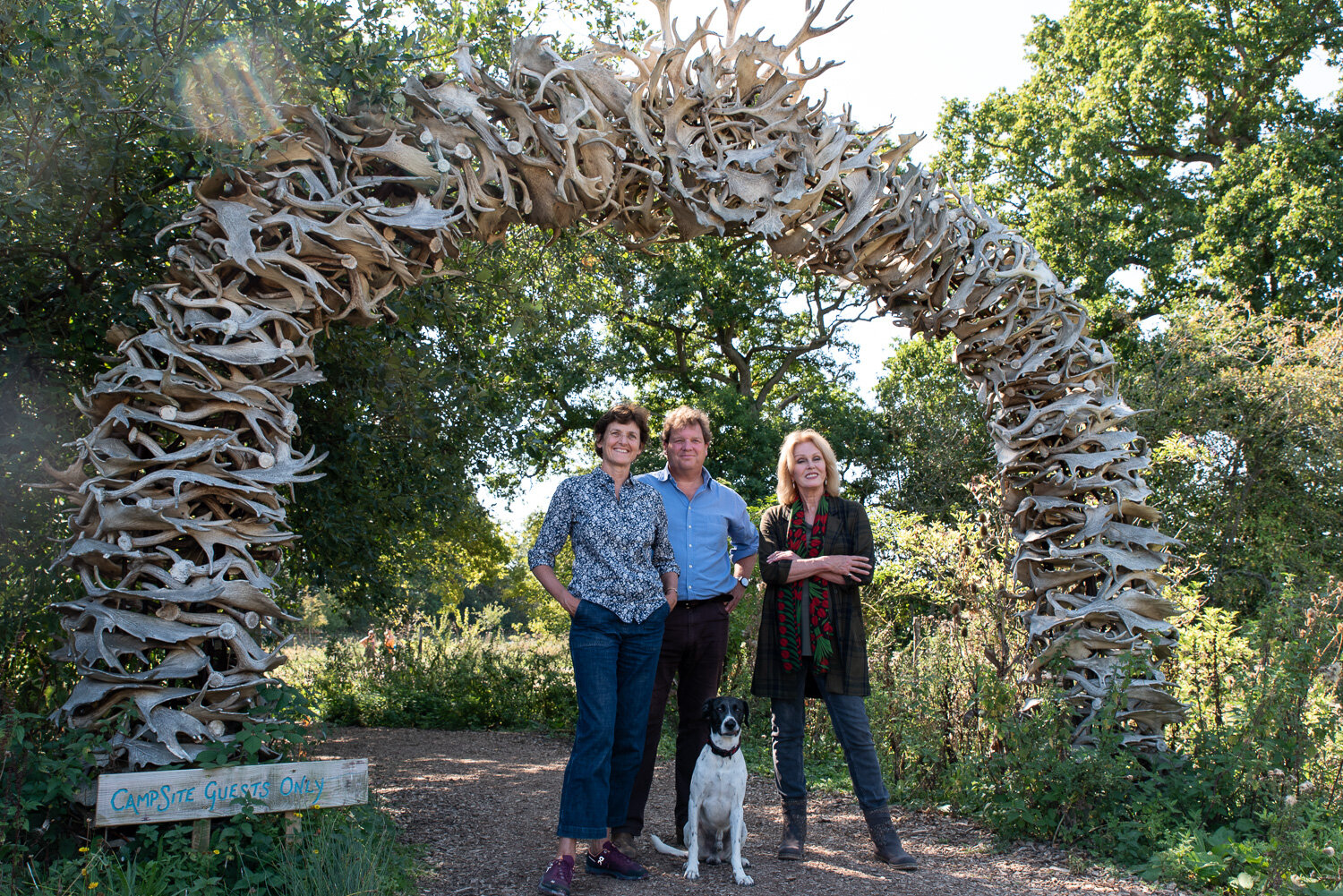
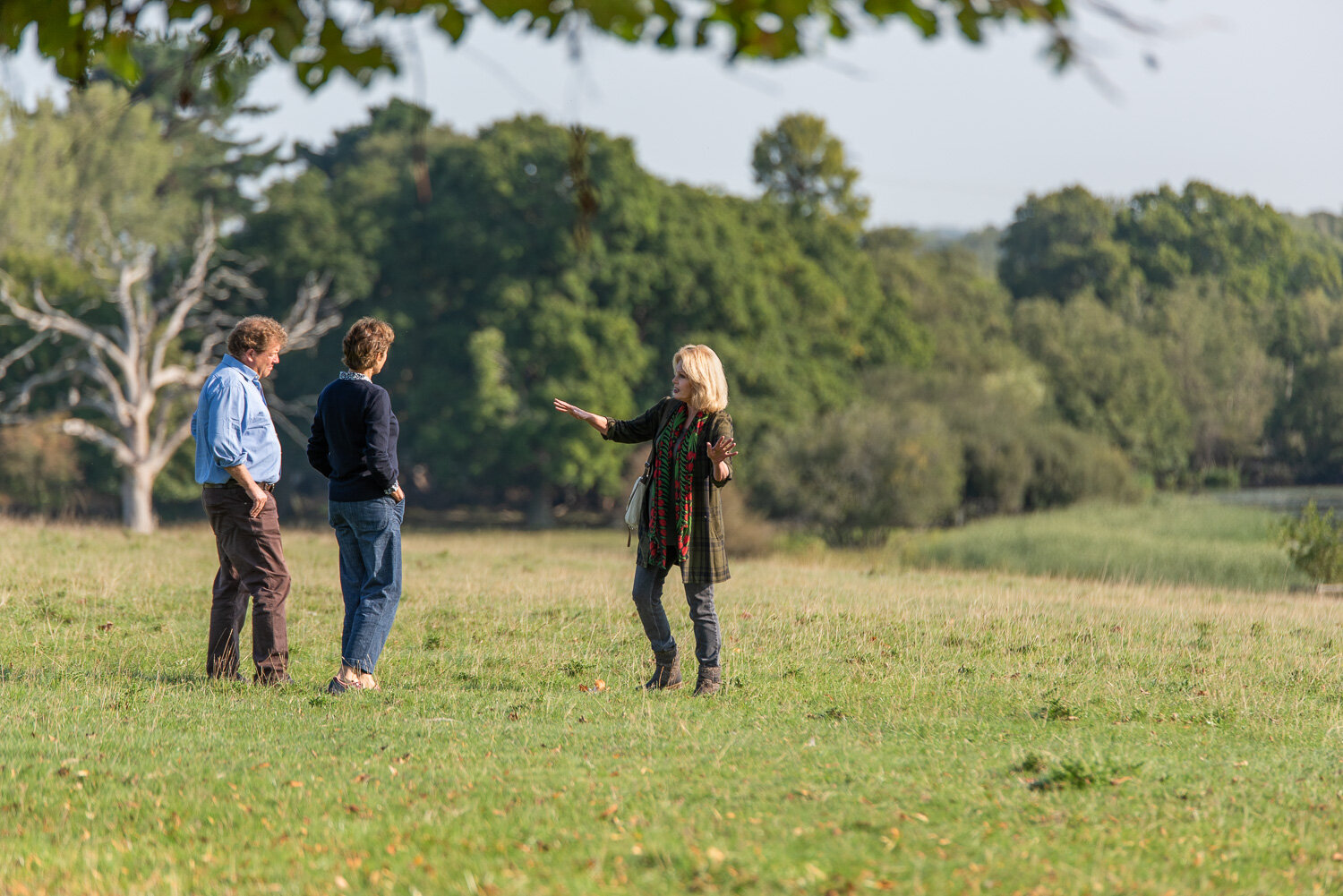
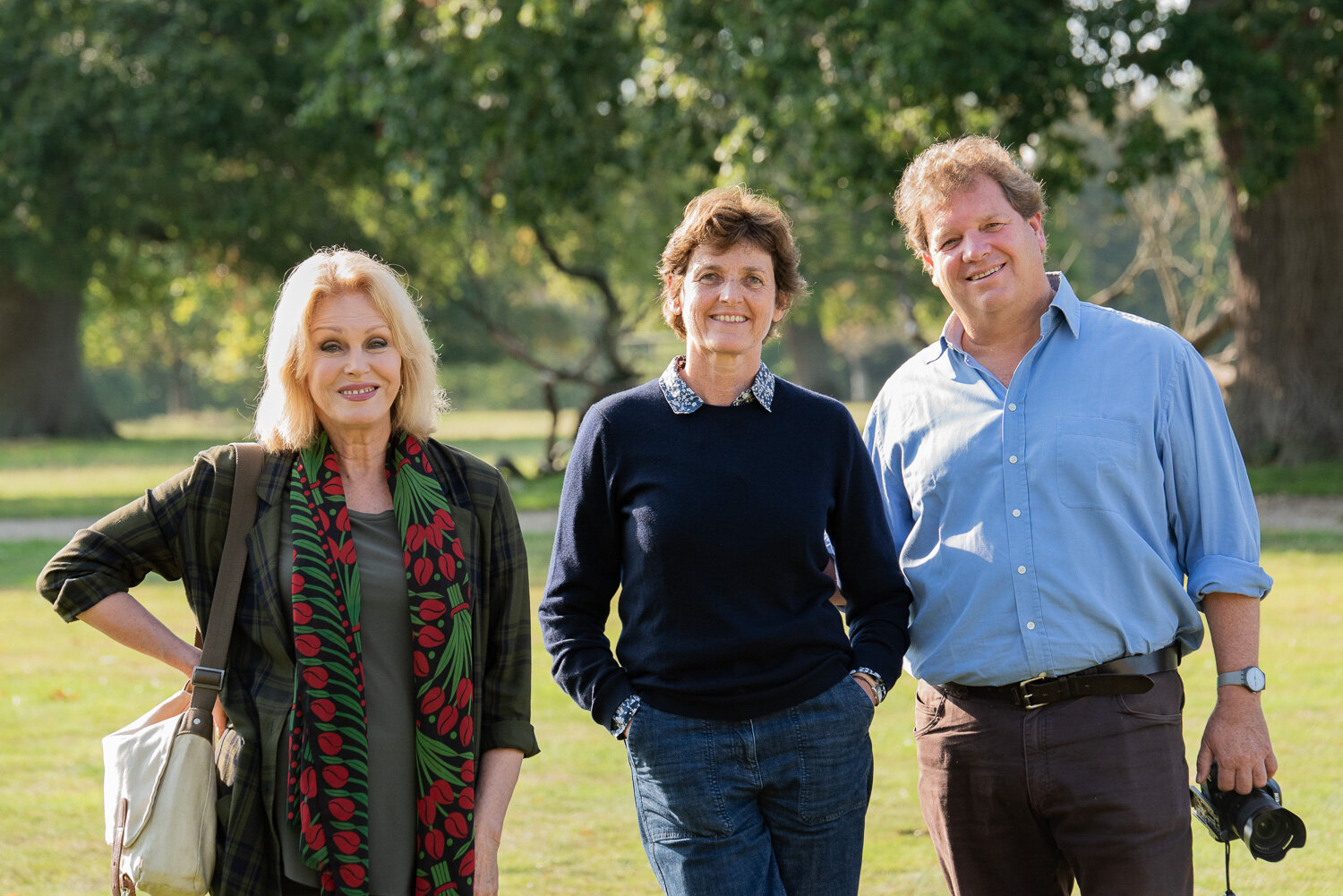
Knepp Wildlands
But that was a distraction to the place itself. If you know what you are looking at, Knepp tells its own story. If you don’t have an interest or background in nature conservation, it does need a bit of explanation, which is why, alongside the income generation potential, they do the Knepp Safaris which I talk about more with Penny and Ivan in the next episode.
Whether or not you have the knowledge or interest, when you start to walk around the Wildlands, you soon get a feeling of being some where unusual for the UK, somewhere different. Our green spaces in the UK tend to be woodland trails, paths through agricultural fields with tightly controlled stock movement, open heathland and moorland (that’s two other whole episodes), river or canal banks, long distance paths, and footpaths or bye-ways with high tightly cut hedges.
One of the majestic Oaks that survived the Second World War
The Knepp Wildland is different. At first glance it is scrubland, with ‘topiaried’ mounds of brambles, stunty thorny trees, areas of ragwort and dock, patches of rootled soil and holes in (relict) hedges made by pigs and deer. There are some majestic old Oaks dominating the skyline, but also new Oaks coming through, protected by the brambles or other thorny scrub. Some parts of the scrub are very dense and difficult to traverse, other are open and have easy to follow tracks made by the free-roaming Red or Roe deer, English Longhorn Cattle, Exmoor Ponies or Tamworth pigs.
Depending on the time of day or year, you are also sometimes bombarded with noise - birds or insects, or in my case at 1 in the morning, the slightly terrifying and primeval noise of rutting deer; I have put some audio clips of birdsong below.
It is also a human landscape in the sense that Knepp have opened up paths, purposefully made it accessible, but been clear about where people are not generally welcome.
Night photo of bramble mounds ‘topiaried’ by the herbivore grazers and browsers and acting as nurseries for the new trees growing through.
I say ‘at first glance’ above because once you start to delve deeper, past the bramble mounds and scrubby Blackthorn, sedges and Ragwort, in fact Knepp is a myriad of different ecosystems and ‘niche spaces’.
It is scrub dominated by Bramble, or by Dog Rose, or by Blackthorn
It is a set of shallow river valleys (laggs) which are relatively unchanged since the project started because they are favoured for grazing
It is patches of relict woodland with a more open understory providing shelter and shade for livestock and home for woodland birds
It is ponds, natural scrapes, streams and waterholes where the free-roaming animals congregate and mingle as they would in Africa
It is open fields - former pastures - that are also favoured by the grazers and appear almost like they did 20 years ago
It is ‘exploded’ hedgerows which have been allowed to expand, grow out, disperse their seeds into fields, provide homes to invertebrates, birds and mammals
It is more traditional open parkland in the romantic tradition, where the deer roam and trees left to die but not taken down or away
It is a place where ‘carbon’ in form of woody material, is in abundance - the climate change mitigation potential of rewilding is huge and that can clearly be seen at Knepp
It is also a place for people to ‘rewild’ themselves a little, to get back to nature, to walk amongst free-roaming animals, nightingale or turtle-dove song, and to perhaps ever so slightly get a feel for what it would have been like in the UK maybe 5 or 6,000 years ago
Free-roaming Tamworth completely unperturbed by walkers
And one of the very special aspects of the place is that as you walk around the Estate, you may just happen accross a family of Roe deer before they spot you and bound away, or have the indifferent snuffle of a Tamworth literally walk right by you rootling for acorns. You might come nose to nose with an English Longhorn Cow, or receive the inquisitive glare of an Exmoor Pony or White Stork (yes, they have storks too) - generally from a distance.
One of the Red Deer introduced herd introduced into the Estate - photo safari style!
“Everybody should be able to walk out of their door into wildlife”
In our landscapes, we are used to order, to conformity, to cows in one field, sheep in another, horses being ridden, pigs in styes. We are not used to them all sharing the same space - with us - as our ancestors would have had it, and this is really something amazing.
And the really special aspect of Knepp is that 20 years ago it was that ‘conformed farm’. It was mixed arable and dairy, so everything you see here, or when you visit, has recovered from an intensively farmed, compacted, ploughed landscape, ‘treated' with chemicals and surrounded by flailed hedges. So how has this happened - have they just left it? … as the phrase goes.
This has been done through a combination of ecological understanding (read about Frans Vera for more), chance, a funding partnership with government, and ‘careful neglect’ - a phase of my own - of the land.
The photos above show the very clear differences between the Knepp Wildlands and the neighbouring fields
The Wildlands can now be said to be anything but neat, and what might be seen as messy or untidy, with scrapes and brambles and ragwort, nettles and dock, pig-rootled areas, horse dung (a beautiful environment for dung beetles), fields with twisted and gnarled trees and shrubs, ‘holey’ hedges and dead trees standing or fallen, are in fact amazing habitats for biodiversity.
I have had the discussion about beauty already - see the case study with Tom Munro - but there is also the opportunity for more traditional picturesque landscapes at Knepp, not so much the bucolic country scenes, but romantic landscapes, particularly in the golden hours of sunrise and sunset.

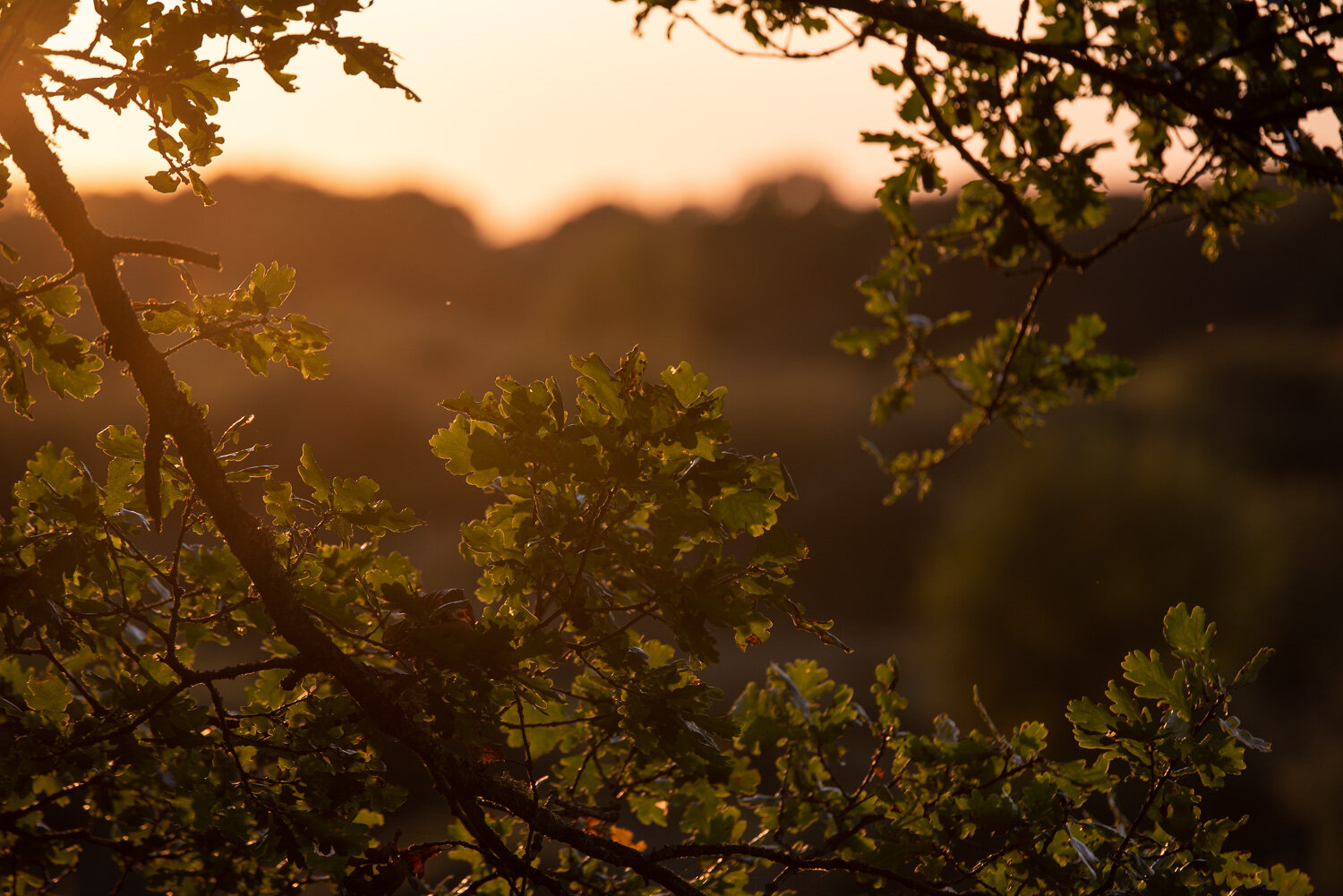
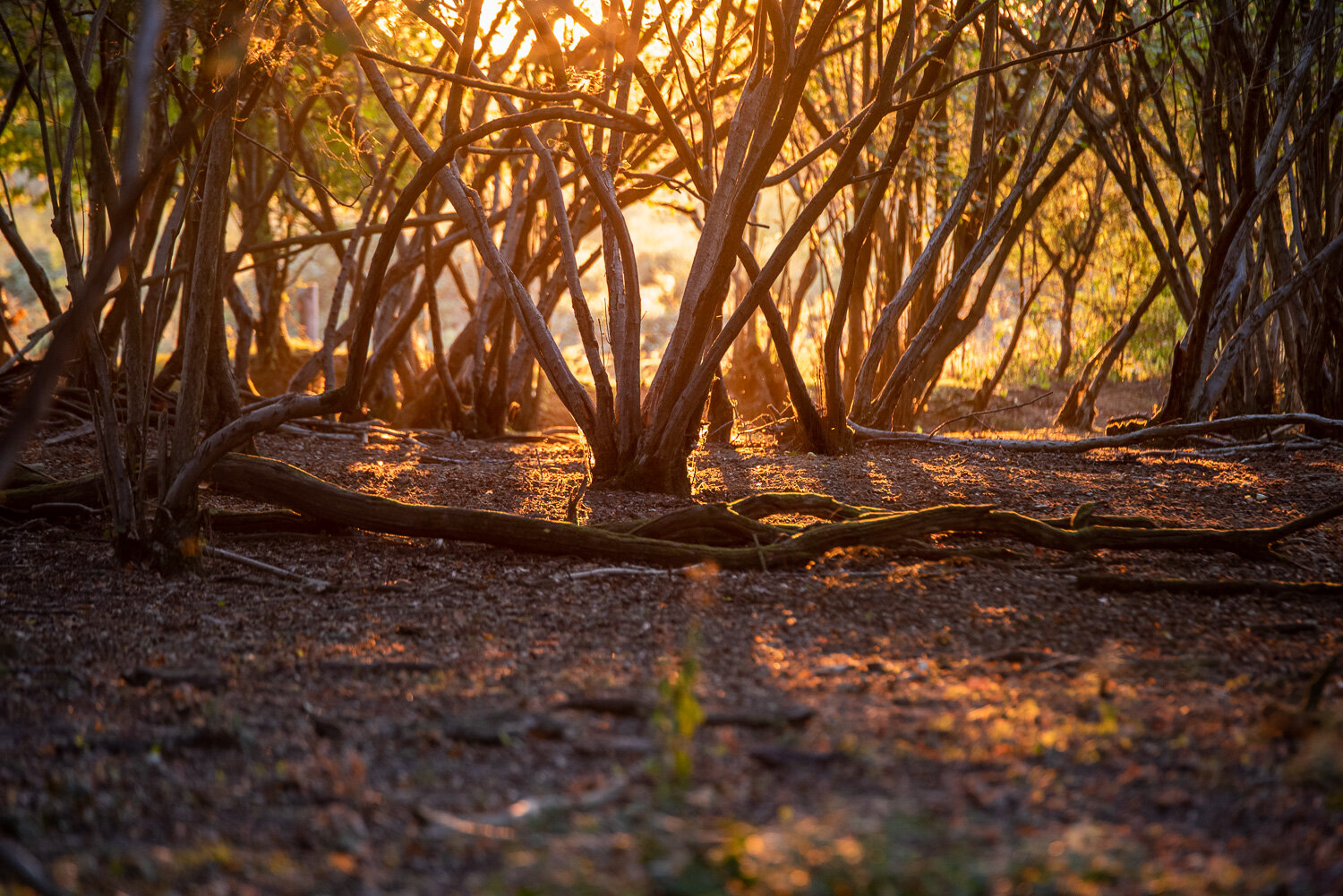
Young male Red deer in the parkland near Knepp Castle
As I have already said, you need to read Issy’s book to get the full story, but the bit I want to talk about most is the Ecosystem Engineers - the resident wildlife - the animals.
The engineers
The free-roaming animals I have mentioned above are, of course, one of the big attractions of Knepp, but they are also the driving force of change. There is an excellent explanation of how the large herbivores drive change here, and also on the Rewilding Britain website, but in essence it is all about disturbance and stopping a natural succession. As I have said before, and as Issy says on the podcast, if 'you just leave it’ the vegetation would revert to woodland. Now although we all love woodlands, they do not allow the sheer diversity and abundance of life of a mixed ‘mosaic’ ecosystem; the simple fact of canopy shading prevents the growth of many plants on which animals such as small mammals, birds and insects survive.
In contrast, the mixed open scrubby vegetation, with all stages of the ecological succession present, allow biodiversity to flourish at all levels.
The herbivores all have different roles:
The grazers such as the cattle often seek the more nutrient dependent grasses, thus allowing the stress tolerant wild flowers to emerge, but the hardy cattle also keep the bramble and sallow (Willow) at bay so allowing other species to compete.
The browsers such as the deer and horses nibble the tops of saplings stunting their growth and slowing the succession to woodland. Issy says in the interview about the role of horse saliva actually promoting growth - there will be thousands of tiny interactions of this type that we will never know about.
And then there are the pigs, the rootlers, and in my view the stars of the rewilding world. They scuzz around in the vegetation and dig up the soil looking for acorns and tasty roots thus allowing opening up the soil for a whole new set of seeds to germinate.
There are of course beavers too, but I will come on to them in another case study, and Knepp don’t have any at present.
One other key role is that as big shaggy animals, the large herbivores all play a key role in seed dispersal on their fur, essential for abundance and diversity.
Disturbance is good for biodiversity - diversity creates diversity - and the big beasts you see at Knepp are the reason why it is at as it is, why Purple Emperor and Marble White butterflies have come back in large numbers and why Turtle Doves are back and trilling away regularly… and why you can’t turn you back for a moment or you will miss a Treecreeper!
This is a short recording of a Turtle dove, a bird who’s population in the UK fell by 77 per cent between 1970 and 2001. I am no birder, but it was a special moment to hear it.
But to me the case of the Nightingales (no photo or audio, sorry) is so important, in that they have been shown to actually prefer the herbivore managed scrubland, and in fact are not the exclusively woodland birds we thought they were; it was just that we have damaged nature so much that they had been relegated to woodlands.
Key to the success of the Wildlands for biodiversity is that whilst the animals are for the most part left to their own devices, with no supplementary feed, there has to be an annual ‘take’, so as to prevent overgrazing and starvation. Although it looks like the savannah, it is tiny in comparison, it is still fenced in and there are no natural predators - no lions to manage population levels. So the take is essential, and the income from the sale of the ‘carbon positive’ meat, along with the safaris, subsidy and consultancy enable Knepp to remain a rewilded landscape.
One of my key realisations over this journey of rewilding is to do with money flow. A farmer may get a good return on a field of wheat for example, but their inputs - seeds, chemicals, tractors, fuel, staff time - are also huge, so whether they make any money that year will depend on factors such as the price of grain on the world market vs their input costs. It is cash-high (most if which goes to agro-industry) and profit-low.
If you take out almost all of your inputs, then pretty much anything you make from the land (‘wild’ meat, subsidy, camping etc) is margin.. so cash-low, but with-profits. Charlie told me that the return on the land per hectare now is greater than they were getting under the intensive farming regime, it is just the quantity of produce that is lower. If, as Ali Driver said, 40% of all of our food is wasted anyway - an appalling fact - then I see no harm in some of the UK’s farmland changing to this model, with the huge benefits for nature that come with it. But that’s easy for me to say…
Young Fallow deer in the Wildlands.
My interview
So, enough of the background. The podcast below is worth a listen - it is so much better to hear it first hand rather than my summary, and Issy and Charlie have a lot of great stuff to say. It was back in September 2020, but fundamentally nothing has changed so it is not out of date.
If you press Play below you get a 30 second snippet because that is all Spotify allow you to put in a web page - but if you click the link rather than the Play arrow, it will take you to the podcast on the Spotify app or webpage. :)
It was a great conversation, covering the history of the project, some facts and some stories, some discussion of imagery - this is a photography project after all - and a wonderfully creaky old leather chair noise every few minutes.
Issy and Charlie and their doggy (who’s name i have forgotten)
The Estate Office and a rather wonderful old map!
One thing amongst many that stuck out to me was both Issy and Charlie’s mentions of the amount of noise that you hear at Knepp; birds in Spring, insects in summer, and as have already said, deer rutting later in the year. This is a very obvious and very special sensory experience that we so often don’t have, surrounded by cars, people, headphones and fields bereft of life.
So that you can experience it, I have also attached an audio clip of morning summer bird sounds so that you can experience it for yourself . So sit back, headphones on (!), and picture yourself at 5.32am in the Knepp Wildlands. For an even more chilled experience, use the soundtrack from the video below - 6 minutes of uninterrupted 7am birdsong from Knepp, including Turtle Doves.
In the conversation with Charlie and Issy, we talk about scale, large and small, about protected areas and how they work and don’t work, and also about whether rewilding should be on marginal land or not. Charlie’s very firm views was that if you stick to just the more marginal land with a natural process based approach then you are “denying people to have nature on their doorstep”, something I very much agree with, but I know that we cannot rewild everywhere in England else food production will be too low.
As ever, I encourage you to take your own view about what they have done and how you think this works for nature and people. Yes at Knepp they have the land and the estate history, but they were losing money and took a huge risk. Yes they have have ended up with subsidy from Government - no different in many ways to most farms in the UK - but boy they had to fight for it. Yes, they have had complaints - a lot of complaints - but those have now faded and people are so complementary… but there will always be some people who want the neat and ordered green and pleasant land.
At the end of the day/20 years, the gains for nature at Knepp have been immense, but in my view the gains for nature nationally that their risk-taking has led to, through inspiring people and sharing their time and expertise, is immeasurable. It is a paradigm shift in nature restoration and long may this shift survive.
A classic Knepp landscape, Oak, scrub, browsers (deer), bramble mounds and young tree growth
“[Rewilding] is putting the drivers in place. It is kickstarting the systems again. You have to initially do something to pull the glider back up in the sky”
So that’s where I am stopping for now, but the next episode will have more about Knepp, including some pre-dawn photos, the white storks and some audio of cows munching. At time of writing I have paid four visits to the estate, and they won’t be my last. Every time there is something different. I still have not managed to see one of the famous Purple Emperor butterflies, or heard a Nightingale sing in the dark, but I will be back.
Issy’s book is an inspiration to many people, and I have been lucky enough to see the changed landscape first hand. As she says, it gives hope, hope that even though we have done a grand job of stuffing up our landscape and biodiversity, there are ways back from the brink, as long as we work with and listen to nature.
To end…
The following is a short video of drone footage over the Wildlands, giving an idea of scale, diversity and morphology of the vegetation. It was taken in July 2021 and the birdsong was recorded in the reserve on the same day as the drone footage - if you listen carefully you can hear the elusive Turtle Dove. The circular ‘topiary’ bramble mounds are also very evident and you can see their role as a nursery to the trees poking out of them.
It is a quite a relaxing video apart from some dodgy drone flying, and lasts about 5 minutes, so sit back and enjoy…
I hope you like the photos and the interview. My thanks to Charlie and Issy for being so generous of their time, and to Ivan, Penny, Emma, Pat and the other Knepp staff for putting up with my loitering. My thanks to you for listening and looking - please sign up to my email list here, and add a comment below if you wish.
If there are any terms that you don’t understand, please do look at the FAQs and links or drop me a note and ask.
If you like this, please remember that I am not paid to do it in any way and I fit the podcasts in around my day job and MA Photography, so if you feel like buying me a coffee, I would be delighted to accept, See the link below, and thank you in advance :).





